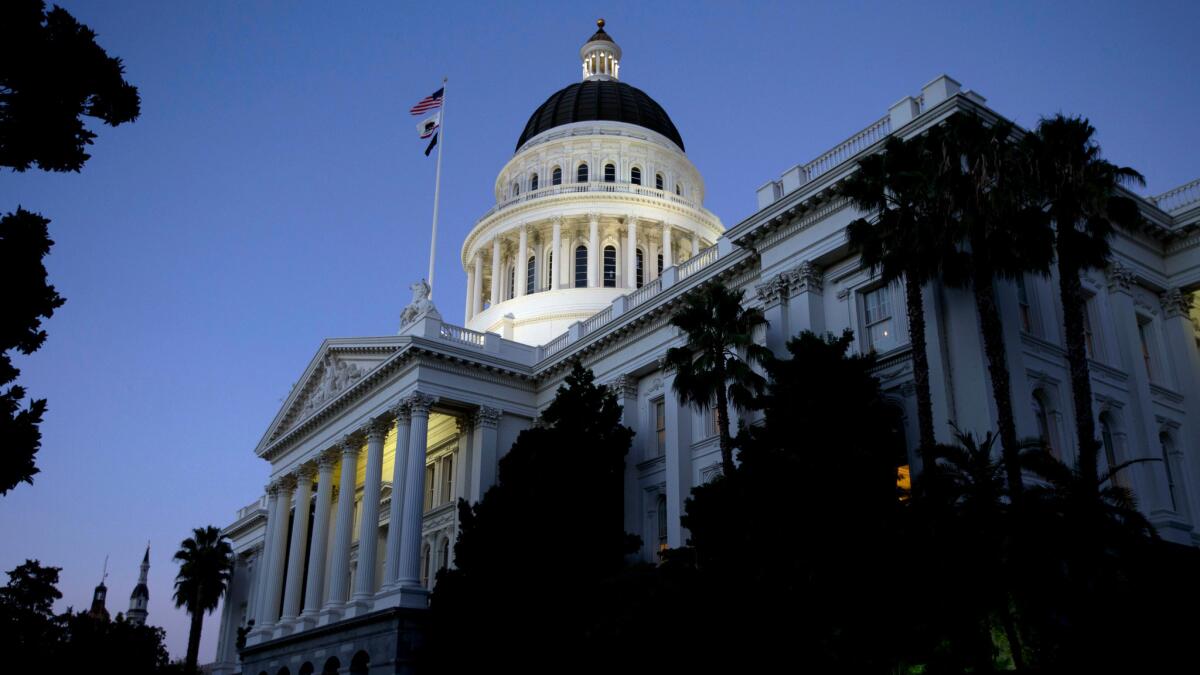Column: Political Roadmap: Don’t expect big changes if Democrats win a Sacramento supermajority on Nov. 8

Reporting from Sacramento — Even Republicans, who would love to change the balance of political power in Sacramento, know which party will control both houses of the Legislature after Nov. 8.
The only real election drama is if Democrats can grab at least 54 seats in the Assembly and 27 seats in the Senate — a two-thirds supermajority long seen as the Holy Grail of state government politics.
With a supermajority, a political party can raise taxes, place measures on the statewide ballot, enact laws immediately with an “urgency” clause and override a governor’s veto. In theory, it’s an enormous amount of power.
Democrats grabbed two-thirds of all legislative seats in 2012 — the first time any political party had done so in both houses since 1933 — aided by newly drawn political maps and President Obama’s romp over Mitt Romney.
Republicans erased that Democratic supermajority in 2014 by throwing everything they had into legislative elections. And they’re trying to hang on this year.
“They’re fighting to stay alive,” said Darry Sragow, publisher of the nonpartisan Target Book that handicaps state politics. “They’re fighting to stay relevant.”
Democrats can reclaim their Assembly supermajority by winning two of the four seats they lost in 2014. These closely watched races in communities surrounding Torrance, Santa Ana, Palmdale and the suburbs east of San Francisco are attracting millions of dollars in campaign cash.
Big money is also at play in an effort to oust a Republican assemblyman near San Bernardino. Democrats would also love to steal an Assembly seat near Corona that’s in the GOP column.
“The Republicans are in this very difficult, unenviable position,” Sragow said.
Political Roadmap: There’s a reason why Gov. Brown signs so many bills »
In the Senate, the path looks more narrow even though Democrats only need to pick up a single seat. Contested districts in the Antelope Valley and northeast Orange County have usually been won by Republicans.
Sragow said he believes that GOP voters won’t abandon down-ticket races, even in this difficult presidential season and with 16% of voters saying they don’t plan to vote in the U.S. Senate contest between two Democrats.
“If political insiders are assuming that, because of Donald Trump’s unpopularity in California, fewer Republicans are going to turn out and vote, that assumption would be a huge mistake,” he said.
Still, let’s play out the “what if” game: What could Democrats do with a supermajority of seats in the Legislature?
In truth, it’s probably more bragging rights than brawn.
Business groups that used to spend campaign cash electing Republicans now work to elect kindred souls who happen to be Democrats. That’s made the majority party, especially in the Assembly, a lot more heterogeneous.
Recent battles, from climate change policies to workplace rules, have proved how fractious Democratic politics can be.
And there’s still the governor to stop liberal-leaning tendencies. A former leader of Assembly Republicans once famously called Gov. Jerry Brown “the adult in the room” when it comes to saying no.
The more perilous question for Republicans is what happens in 2018 and beyond. Under the term-limits law revamped by voters four years ago, newly elected legislators can serve up to 12 years. That means even Democrats who don’t agree on everything would be in a position to act unilaterally should they agree to close ranks.
Follow @johnmyers on Twitter, sign up for our daily Essential Politics newsletter and listen to the weekly California Politics Podcast
ALSO
There are now more registered voters in California than the population of 46 states
Will these Southern California Republicans keep their Assembly seats despite Trump?
What you need to know about the legislative races after the primary
Here’s a look at what the California Legislature did, and didn’t, do in its two-year session
Updates on California politics
More to Read
Get the L.A. Times Politics newsletter
Deeply reported insights into legislation, politics and policy from Sacramento, Washington and beyond. In your inbox three times per week.
You may occasionally receive promotional content from the Los Angeles Times.











